It's a bit
hard for me to believe now, but I used my
first Japanese baren for literally years
without changing the cover. Why so hard to
believe? Well now with quite a few barens on
hand, and sometimes changing them
daily, the idea of using one for such
a long time is simply inconceivable.
One reason that it 'lasted' so long is
that I wasn't really using it properly - I
didn't put much strength behind my rubbing,
and the bamboo skin cover thus did
last a long time. But of course it gradually
developed holes and torn spots, and I
struggled with tape and whatever I could
think of to keep it together.
Looking back now, I regret very much that
I treated the tool so badly; it should have
been a matter of common sense that a printer
should keep his primary tool in good
condition ...
But changing the cover is a
difficult job. In one sense it's quite
straightforward - just moisten a piece of
bamboo, wrap it around the baren, and tie it
somehow on top. That method works alright ...
if you are not so demanding about how
you intend to use the tool, and if the kind
of printing you are doing does not involve
too much physical pressure. But if you need
good control over the tool, and certainly if
you wish to be able to print deep and smooth
colour, the baren must be tied correctly -
and correctly in this case means
tightly!
Let me 'walk' you through a series of
photographs taken as I tied one of my barens
...
(Please note: I am
left-handed. That doesn't make any difference
at all in the way that a baren is tied, as it
is of course a symmetrical tool, but it might
make it a bit difficult for you to 'copy'
what you see in these photos. If this bothers
you, just download the images to your own
computer, and 'flip' them in a graphic
program ...)
Here are the tools and materials I use:
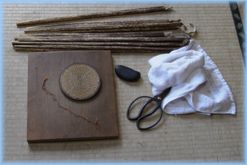
- The bare baren ready for covering is
resting on a plank of hard cherry wood.
This particular board is used only
for this baren-tying job - it must be
perfectly smooth with no dents or deep
scratches. Softer wood is not suitable,
nor is a board that is too hard.
- A length of strong cord is ready
(actually the same length that just came
off the old cover a moment ago). Not
visible in the photograph are the small
knots tied at each end (to allow the cord
to be gripped and pulled tightly during
tying).
- I use a pair of strong shears to cut
the skin to the correct shape.
- The black object is a stone, for
rubbing the skin to break down the rough
fibres.
- At the top are a few rolled-up bamboo
skins from which I will choose a good
skin, and a hand towel rounds off the
'bill of materials'.
Here are two skins:
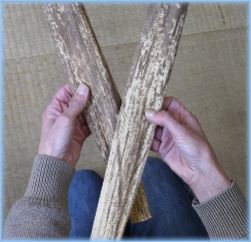
... the one that will be most suitable for
the baren cover is the light-coloured one.
Skins with large areas of brown are nearly
always too soft and soggy to make a good
cover.
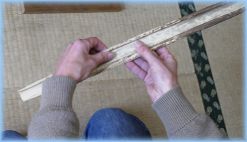
Only unroll it far enough to test the
thickness with your fingers; opening it up
any farther than this will almost certainly
crack or split it. In general, a thinner skin
is preferable to a thicker one - it might not
last quite as long, but it will be much more
responsive in use.
It is not necessary for the skin to have
any advance preparation - soaking, etc., etc.
When you are ready to put a new cover on your
baren, simply select a skin and take it over
to the sink. Unroll it under running water
...
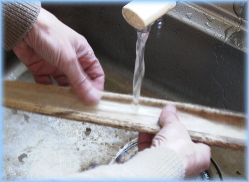
... opening it up bit by bit and allowing
the water to flow along the length of it.
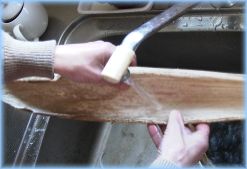
Once it is open, flip it over and get the
entire skin good and wet. Around a minute
should do it. Using warm water helps to
prepare the skin for the subsequent steps.
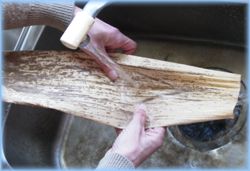
The next part of the procedure is designed
to get the skin softened up:
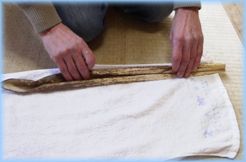
Roll it up into the light towel, leaving
an inch or so of the root end of the skin
protruding from the roll.
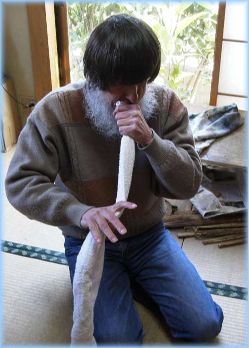
Time for some flute playing! Spend a
minute or so blowing through the roll as you
squeeze tightly while running your hand down
the length of the towel, bending the skin at
a sharp angle as you do so. Your warm and
moist breath will leave the skin very soft
and supple.
Move on to the second
page ...







